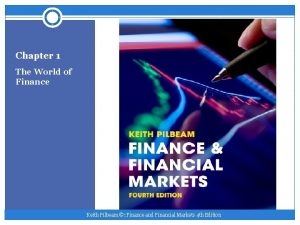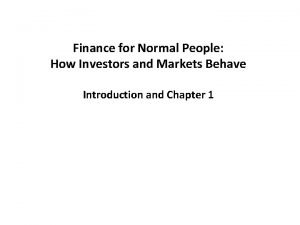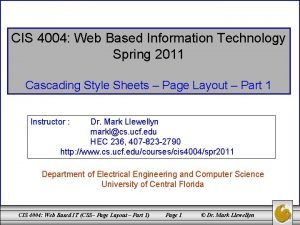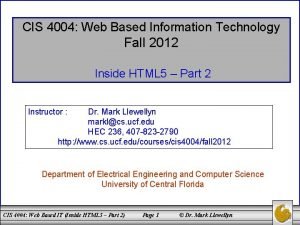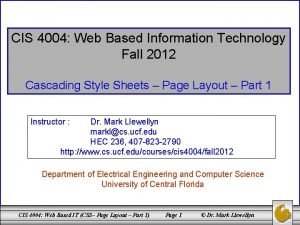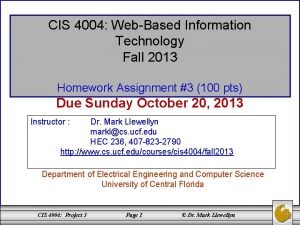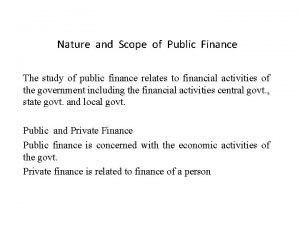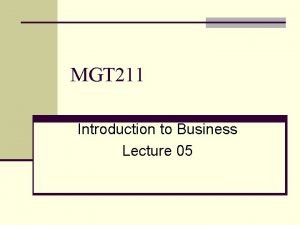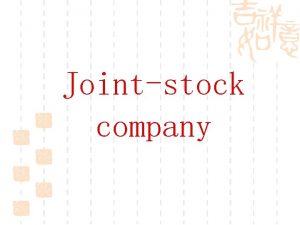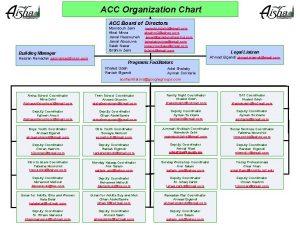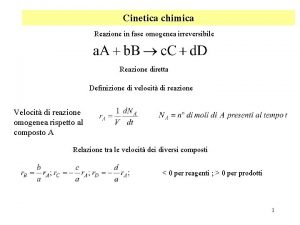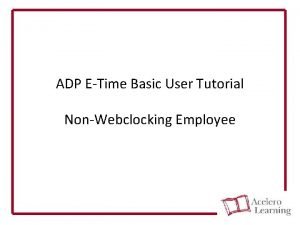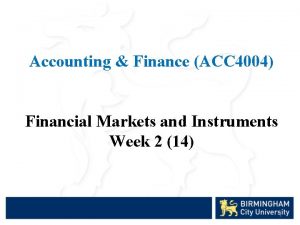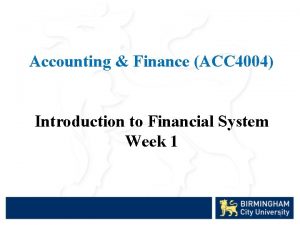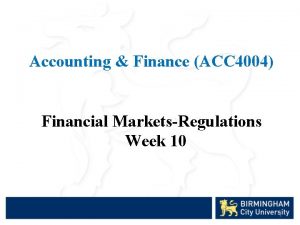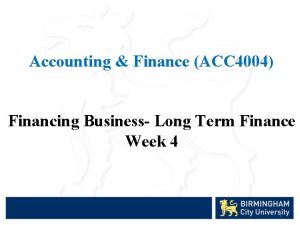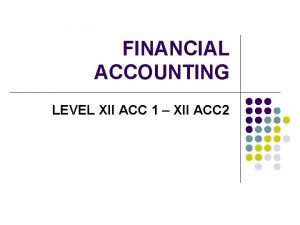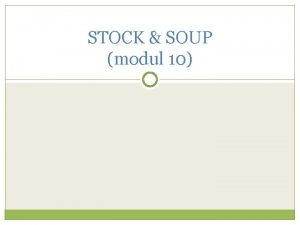Accounting Finance ACC 4004 Stock Markets Introduction Importance























































- Slides: 55

Accounting & Finance (ACC 4004) Stock Markets - Introduction & Importance Week 5 (a) 1

Learning Objectives: • Stock Exchanges • Importance and tasks of stock exchanges • Stock bubbles • London Stock Exchanges (LSE) • Methods of finding attractive shares 2

Stock exchanges around the world • Stock exchanges are markets where government and industry can raise long-term capital and investors can buy and sell securities. • Transferability of ownership of financial assets was an important breakthrough for the development of sophisticated financial systems. • The second major breakthrough was the introduction of limited liability for shareholders in 1855 in UK. • Now over 140 countries with officially recognised exchanges. Glen Arnold, Corporate Financial Management, 5 th Edition © Pearson Education Limited 2013

Stock exchanges around the world (Continued) Relative sizes of global stock markets by market capitalisation. Source: from Global Investment Returns Yearbook 2011, Credit Suisse Research Institute (Dimson, E. , Marsh, P. and Staunton, M. 2011) © Elroy Dimson, Paul Marsh and Mike. Staunton. Glen Arnold, Corporate Financial Management, 5 th Edition © Pearson Education Limited 2013

Stock exchanges around the world (Continued) The world’s twenty largest stock exchanges at the end of 2010, ranked according to domestic market capitalisation of equities 1 The total value, at market prices, of all issued shares of companies quoted on the stock market. Source: World Federation of Exchanges: www. worldexchanges. org. . Glen Arnold, Corporate Financial Management, 5 th Edition © Pearson Education Limited 2013

A well-run stock exchange has a number of characteristics • A ‘fair game’ takes place • Not possible for some investors and fund raisers to benefit at the expense of other participants • ‘A level playing field’ • Well regulated to avoid abuses, negligence and fraud • Reasonably cheap to carry out transactions • A large number of buyers and sellers

The importance of a well-run stock exchange • Firms can find funds and grow • Allocation of capital • For shareholders • Status and publicity • Mergers • Improves corporate behaviour

Tasks for stock exchanges • Supervision of trading to ensure fairness and efficiency • The authorisation of market participants such as brokers and market makers • Creation of an environment in which prices are formed efficiently and without distortion (price discovery or price formation) • Organisation of the settlement of transactions • The regulation of the admission of companies to the exchange and the regulation of companies on the exchange • The dissemination of information.

Why do companies list their shares on more than one exchange? • To broaden the shareholder base • The domestic stock exchange is too small or the firm’s growth is otherwise constrained • To reward employees • Investors in that particular market may understand the firm better • To raise awareness of the company • Discipline • To understand better the economic, social and industrial changes occurring in major product markets

Bubbles An economic cycle characterized by rapid expansion followed by a contraction. • Tulip Mania (bubble) ( 1636) • South Sea Bubble (1711) • Railway ( 1840’s) • US pre Depression (1929) • Dot- com (1999 -2001) A good video about bubbles can be viewed at http: //www. youtube. com/watch? v=_Mm-n. LKa. Kk. E&list=PLB 4 AF 88 D 9 AA 51 B 2 DA

The London Stock Exchange Exhibit 9. 12 Types of financial securities sold on the London Stock Exchange

The UK equity markets available to companies • The Main Market (Official List) • The Alternative Investment Market (AIM) – No requirement for AIM companies to be a minimum size – No requirement for a company to have traded for a minimum period of three years – No set proportion of shares to be in public hands – Nominated adviser (‘nomad’) – Nominated brokers – The annual cost of being quoted on AIM runs into tens of thousands of pounds • Tech. MARK – All companies joining tech. MARK have a market capitalisation of at least £ 50 m and they must sell at least £ 20 m worth of new or existing shares when floating – At least 25 per cent of their shares must have a free float – Publish quarterly reports – AIM admission document

The primary market (equities) • 2011 – Over 1, 000 UK companies on the Main Market and 80 UK companies on the tech MARK – Over 1, 100 companies on the Alternative Investment Market Exhibit 9. 14 Money raised by UK companies, 1999– 2011 *Includes non-UK companies Source: London Stock Exchange, www. londonstockexchange. com. Reproduced courtesy of London Stock Exchange plc.

The secondary market in equities Exhibit 9. 15 Distribution of UK companies by equity market value at August 2011 for Main Market and Tech. MARK. The AIM numbers include non-UK companies Source: www. londonstockexchange. com, statistics section. Reproduced courtesy of London Stock Exchange plc.

London Stock Exchange Indices • Indices – A market index tracks the performance of a specific "basket" of shares considered to represent a particular market or sector of the a stock market. – Mostly market value weighted: the average is derived by weighting each share by the size of the company • • FTSE 100 The ‘Footsie™’ (Top 100 companies on LSE) FTSE All-Share FTSE 250 FTSE 350 FTSE Smallcap FTSE Fledgling FTSE AIM All-Share FTSE All-small

Price weighted index 12/31/2003 = (15 + 25 + 40 + 80) = 40 4 Price weighted index 12/31/2004 = (10 + 30 + 40 + 100) = 45 4 Market weighted Index = 390, 000 = 35. 5 11, 000 16

Understanding Financial pages: London Share Service extracts - Aerospace and Defense

Six methods for finding attractive shares • Economic cycle • Big Themes • Scuttlebutt • Directors’ dealings • Newspapers and magazines • Excessive falls

Method 1. Economic cycle • Over time the economy goes through periods of growth and periods of contraction. This economic cycle is natural and has recurred throughout history. • The economic cycle allows us to classify shares into two types: • i) Cyclical shares • ii) Defensive shares

Cyclical sectors Defensive sectors Aerospace Automotive Banks Construction Engineering and Industrials Media Manufacturing Mining Property Retailing Travel & Leisure Food Beverages Healthcare Household goods Insurance Pharmaceuticals Support Services Tobacco Water When considering shares to buy, bear in mind the prevailing stage of the economic cycle. In theory, when the economy is growing strongly, cyclical shares tend to perform well; while in a downturn defensive shares should – if not perform strongly – at least outperform cyclical shares.

Method 2. Big Themes • One of the major themes of the 21 st Century is likely to be the continued development of the emerging economies and the huge expansion of the middle classes within those countries, such as: Luxury consumption of cars, fashion, wines and other items are likely to soar in the emerging economies leading to strong demand for companies active in these areas. • Other Big Themes are likely to be the aging population in developed markets, increasing urbanisation, and the tasks of feeding the world and powering it. • This can lead to many investment ideas.

Sector Theme Company examples Education is soon to become an integrated, global, digital business with demand innovation driven – as in so many (other) areas - by the emerging markets. Pearson Pharmaceuticals Global healthcare spending is set to soar with a combination of people living longer in developed countries and middleclass consumer populations growing in emerging markets. Glaxo. Smith. Kline Mining The urbanisation and infrastructure development of China and other emerging markets is likely to provide strong demand for resources for a period of many decades. Rio Tinto Luxury consumption The global middle class is set to expand rapidly as emerging economies become wealthier. As this happens consumption will increase, especially the discretionary element where brand names are all-important. Burberry Africa China is investing billions in Africa's resources which will help trade and economic growth there for decades. But Africa is also growing internally with a booming middle class that should drive consumption. PZ Cussons

Method 3. Scuttlebutt • This idea of using personal experience to influence your investing decisions was originally proposed by Philip Fisher who called the process “scuttlebutt”. • Scuttlebutt is an old naval term for gossip or rumour. Sailors would talk around the scuttlebutt (water barrel on a ship) and this would give them a better idea about life on the ship. • Scuttlebutt research is easy. Next time you’re in the high street, see which shops seem to be busy or those shops that seem rather too quiet and just generally unattractive. If you take Easy. Jet flights and find them nearly always full, perhaps the company is worth looking at.

Method 3. Scuttlebutt • Scuttlebutt may seem too easy, but don’t dismiss it – often this subjective experience can be more valuable than the seemingly more objective, but • academic, views of analysts and newspaper • columnists. • Stock market research is often based on historical performance, but your own experiences can show you exactly what’s happening right now. • The internet offers great opportunities to extend the power of scuttlebutt research beyond personal consumer experience to see feedback from thousands.

Method 4. Directors’ dealings • Throughout the year there are certain periods when directors are not allowed to buy and sell shares in their company because they have access to certain privileged information (e. g. in the period just before results are announced). • But for the rest of the year directors can deal in their company shares just like any other investor. The LSE must be informed of all such dealings and this information is then widely disseminated.

On 9 November 2011 Admiral shares fell over 25% following a negative reaction to the company’s third quarter results. Seven directors felt the selloff was overdone and invested a combined £ 11. 1 m in the shares. In the following months the shares recovered most of their losses from that day, and in March the company released record profits for the eighth consecutive year.

Method 5. Newspapers and magazines Many investment ideas can be found in the stock market columns of newspapers, magazines and online, where there’s no shortage of tips. • Remember you make money when you sell the shares (not when you buy them). Therefore, when you sell is also important • The second thing to be aware of is that when a share is tipped in the media its price can jump up immediately, simply due to the increase in buyers, and may then slip back again as the buying pressure reduce. Look at http: //www. sharetips 365. co. uk/sharetips-2013/sunday-times/ and look at whether the price moved.

Method 6. Excessive falls • Aka Bottom Fishing • The market can over-react to profit warnings and the shares become over-sold. This method of selecting shares is not without danger. Sometimes shares fall for a very good reason and continue falling. The skill is in finding companies that are fundamentally sound but have been over-sold in the short term.


Bibliography Howells, P. and Bain, K. , (2007) Financial Markets and Institutions. 5 th ed. England: Pearson Howells, P. and Bain, K. , (2005) The Economics of money, banking and Finance: A European text. 3 rd ed. England: Pearson Mishkin, F. S. and Eakins, S. G. , (2009) Financial Markets and Institutions. 6 th ed. Boston: Pearson Arnold, Glen. (2013) Corporate Financial Management. 5 th ed. Pearson Arnold, Glen. (2012) Modern Financial Markets and Institutions. . Pearson Mc. Laney, Eddie. (2012) Business Finance : Theory & Practice, 9 th Edition, Pearson Education Limited

Stock Markets- Listings and Functioning Week 5 (b) Learning Objectives: • Floatation (Listing) • Issuing Process • Methods of Issue • Costs of new issues • Right Issues 31

Arguments for and against joining a stock exchange Glen Arnold, Corporate Financial Management, 5 th Edition © Pearson Education Limited 2013

United Kingdom Listing Authority (UKLA) Responsible for approval of the prospectuses and admission to the Official List Maintains details of all listed companies and updates its list daily with additions, cancellations, suspensions and restorations It rigorously enforces a set of demanding rules regarding the conduct of the company and its officials in the years following the listing • A company has a track record stretching back at least three years • All companies obtaining a full MM(Main Market) listing must ensure that at least 25 per cent of their share capital is in public hands, .

Floating on the Main Market (Official List) • The United Kingdom Listing Authority, UKLA • Prospectus – A marketing tool – Three years of audited accounts – Details of indebtedness – A statement as to the adequacy of working capital – Statements by experts – Major contracts entered into in the past two years – A description of the risks facing the firm – Shareholding: of more than 3 per cent to be named – A mass of operational data is required – The expected market value of the company’s shares is to be at least £ 700, 000 • Cost of advisers to the new issue will be at least £ 500, 000 Glen Arnold, Corporate Financial Management, 5 th Edition © Pearson Education Limited 2013

Floating on the Main Market (Official List) • Conditions and responsibilities imposed – At least 25 per cent of their share capital is in public hands – Directors may find their room for discretion restricted when it comes to paying dividends. – Loss of some privacy and autonomy – Rules concerning the buying and selling of the company’s shares by its own directors • Suitability – Management team must have the necessary range and depth – A track record – Timing of the flotation – A healthy balance sheet, sufficient working capital, good financial control mechanisms and clear accounting policies Glen Arnold, Corporate Financial Management, 5 th Edition © Pearson Education Limited 2013

The issuing process for the Official List Glen Arnold, Corporate Financial Management, 5 th Edition © Pearson Education Limited 2013

The issuing process for the Official List (Continued) Glen Arnold, Corporate Financial Management, 5 th Edition © Pearson Education Limited 2013

The issuing process for the Official List (Continued) Glen Arnold, Corporate Financial Management, 5 th Edition © Pearson Education Limited 2013

The issuing process for the Official List (Continued) Glen Arnold, Corporate Financial Management, 5 th Edition © Pearson Education Limited 2013

40

Methods of issue • A negotiated Purchase • A competitive Bid Purchase • A commission or Best-Efforts Basis • A privileged Subscriptions • Dutch Auction • Direct Sale • Private Debt Placement

Methods of issue • Offer for sale – Shares are offered at a fixed price – Offer for sale by tender • Introduction • Offer for subscription • Placing • Intermediaries offer • Book-building

Offer for Sale • The company sponsor offers shares to the public by inviting subscriptions from institutional and individual investors. • Sometimes newspapers carry a notice and an application form. • However, most investors will need to contact the sponsor or the broker to obtain an application form. • Also details of forthcoming flotations are available at www. londonstockexchange. com, and www. hemscot. com. • Normally the shares are offered at a fixed price determined by the company’s directors and their financial advisers.

Offer for Sale • A variation of this method is an offer for sale by Tender. Here investors are invited to state a price at which they are willing to buy (above a minimum reserve price). The sponsor gathers the applications and then selects a price which will dispose of all the shares – the strike price. • Investors bidding a price above this will be allocated shares at the strike price – not at the price of their bid. • Those who bid below the strike price will not receive any shares.

Introduction • Introductions do not raise any new money for the company. • If the company’s shares are already quoted on another stock exchange or there is a wide spread of shareholders, with more than 25 per cent of the shares in public hands, the Exchange permits a company to be ‘introduced’ to the market. • This method may allow companies trading on AIM to move up to the Main Market or foreign corporations to gain a London listing. • This is the cheapest method of flotation since there are no underwriting costs and relatively small advertising expenditures.

Offer for Subscription • Similar to an offer for sale, but it is only partially underwritten or not underwritten at all. • This method is used by new companies which state at the outset that if the share issue does not raise a certain minimum the offer will be aborted. • This is a particularly popular method for new investment trusts – if the fund managers do not raise enough to create a large investment company which will be able to pay them large ongoing management fees, then they abandon the whole idea

Placing • Shares are offered to the public but the term ‘public’ is narrowly defined. • Instead of engaging in advertising to the population at large, the sponsor or broker handling the issue sells the shares to institutions it is in contact with, such as pension and insurance funds. • The costs of this method are considerably lower than those of an offer for sale. • There are lower publicity costs and legal costs.

Intermediaries Offer • Another method which is often combined with a placing is an intermediaries offer. • Here the shares are offered for sale to financial institutions such as stockbrokers. Clients of these intermediaries can then apply to buy shares from them.

Book Building • Selling new issues of shares through book-building is a popular technique in the USA. It is starting to catch on in Europe. • Under this method the financial advisers to an issue contact major institutional investors to get from them bids for the shares over a period of eight to ten working days. The investors’ orders are sorted according to price, quantity and other factors such as ‘firmness’ of bid. • These data may then be used to establish a price for the issue and the allocation of shares.

How does an AIM flotation differ from one on the Official List? • Rules are kept as relaxed as possible to keep costs of membership and capital raising to a minimum • Nominated advisers act as an unofficial ‘sponsor’ • The (administrative) cost of capital raising can be as much as 10– 37 per cent of the amount being raised • AIM was designed so that the minimum cost of joining £ 40, 000– £ 50, 000. Frequently more than £ 500, 000 is paid • Need to be public limited companies • Accounts • Produce a prospectus (or AIM document) • Do not have to disclose as much information

The costs of new issues • Administrative/transaction costs • The equity cost of capital • Market pricing costs Glen Arnold, Corporate Financial Management, 5 th Edition © Pearson Education Limited 2013

The costs of new issues Glen Arnold, Corporate Financial Management, 5 th Edition © Pearson Education Limited 2013

Recent much talked about Royal Mail IPO Issue Price: 330 p a share (Govt. sold its 60% share ) Opened at a much higher price and ended on 455 p on first day of trading. It has performed very well since its debut. 53

Rights issues • A rights issue is an invitation to existing shareholders to purchase additional shares in the company • Pre-emption rights • Shares are usually offered at a significantly discounted price from the market value • An example – Swell plc with 100 million shares in issue wants to raise £ 25 m – Existing shares are quoted at 120 p – Issue 25 million shares at 100 p each – A ‘one-for-four’ rights issue – Discount on these new shares is 20 p or 16. 7 per cent

Bibliography Howells, P. and Bain, K. , (2007) Financial Markets and Institutions. 5 th ed. England: Pearson Howells, P. and Bain, K. , (2005) The Economics of money, banking and Finance: A European text. 3 rd ed. England: Pearson Mishkin, F. S. and Eakins, S. G. , (2009) Financial Markets and Institutions. 6 th ed. Boston: Pearson Arnold, Glen. (2013) Corporate Financial Management. 5 th ed. Pearson Arnold, Glen. (2012) Modern Financial Markets and Institutions. . Pearson Mc. Laney, Eddie. (2012) Business Finance : Theory & Practice, 9 th Edition, Pearson Education Limited
 From efficient markets theory to behavioral finance
From efficient markets theory to behavioral finance Pilbeam k. finance and financial markets
Pilbeam k. finance and financial markets Keith pilbeam
Keith pilbeam Normal people chapter 1
Normal people chapter 1 Equity markets and stock valuation
Equity markets and stock valuation Prvi mikroprocesor
Prvi mikroprocesor Ieor 4004
Ieor 4004 Intel 4004 emulator
Intel 4004 emulator Cis 4004
Cis 4004 Cis 4004
Cis 4004 Cis 4004
Cis 4004 Intel 4004 transistor count
Intel 4004 transistor count 1100de0011
1100de0011 4004
4004 4004
4004 Intel 4004 microprocessor
Intel 4004 microprocessor Intel 4004 schematic
Intel 4004 schematic Intel 4004 transistor count
Intel 4004 transistor count Cis 4004
Cis 4004 Camed autorização telefone
Camed autorização telefone Ct-4004
Ct-4004 Cis 4004
Cis 4004 Features of preferred stock
Features of preferred stock White stock dan brown stock
White stock dan brown stock Characteristics of common stock and preferred stock
Characteristics of common stock and preferred stock Pramv
Pramv Scope of public finance
Scope of public finance Financial econometrics
Financial econometrics Importance of finance function
Importance of finance function Importance of joint stock company
Importance of joint stock company Joint stock companies act 1844
Joint stock companies act 1844 Insuficiencia cardiaca clasificacion nyha
Insuficiencia cardiaca clasificacion nyha Us i o um o i orum is os is
Us i o um o i orum is os is Management acc
Management acc Acc sports cardiology
Acc sports cardiology Acc org chart
Acc org chart Acc fleet saver
Acc fleet saver Nom gen
Nom gen Ib dt
Ib dt Acc maturity model
Acc maturity model Acc catema
Acc catema In-out+gen=acc
In-out+gen=acc Acc shared memory
Acc shared memory Acc structured reporting
Acc structured reporting Control acc
Control acc Control acc
Control acc Acc etime
Acc etime Control acc
Control acc Acc etime
Acc etime Subgenual acc
Subgenual acc Acc
Acc Acc amic
Acc amic Nom gen dat acc abl
Nom gen dat acc abl Acc structured reporting
Acc structured reporting Acc value challenge
Acc value challenge Acc 3200
Acc 3200


